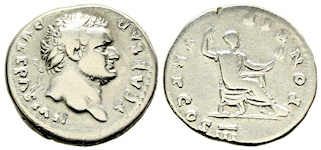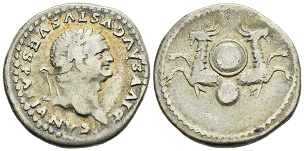Fine Coins Showcase
Antiquities Showcase
Show Empty Categories
Shop Search
Shopping Cart
My FORVM
Contact Us
About Forum
Shopping at Forum
Our Guarantee
Payment Options
Shipping Options & Fees
Privacy & Security
Forum Staff
Selling Your Coins
Identifying Your Coin
FAQs
zoom.asp
Home ▸ Catalog ▸ |Roman Coins| ▸ |The Twelve Caesars| ▸ |Titus||View Options:   | | | | | | Titus Flavius Vespasianus was the hero of the Judean rebellion (from the Roman perspective) and a very popular emperor. He presided over the empire during the cataclysmic eruption of Vesuvius, which buried half the towns of the Bay of Naples, including Pompeii. He was described as handsome, charming and generous. Titus once complained that he had lost a day because twenty-four hours passed without his bestowing a gift. He was, however, generous to a fault, which depleted the treasury. If he had ruled longer, he might have brought the empire to bankruptcy and lost his popularity. He died of illness in 81 A.D., succeeded by his brother Domitian. |


During his father's rule, Titus gained notoriety in Rome serving as prefect of the Praetorian Guard, and for carrying on a controversial relationship with the Jewish queen Berenice.RS114332. Silver denarius, RIC II V705, RSC II 161, BMCRE II V150, Hunter I 10, SRCV I -, aVF, light marks, tiny edge crack, weight 3.134 g, maximum diameter 18.8 mm, die axis 180o, Rome mint, as caesar, 74 A.D.; obverse T CAESAR IMP VESPASIAN counterclockwise from lower right, laureate head right; reverse PONTIF TR P COS III (priest, holder of Tribunitian power, Consul 3 times) counterclockwise from lower right, Titus seated right on curule chair, long scepter vertical in right hand, palm branch in extended left hand;
Vespasian, 1 July 69 - 24 June 79 A.D., Commemorative Issued by Titus


One 23 June 79 A.D. Vespasian died from fever and diarrhea. Known for his humor, his last words on his deathbed were, "I think I'm turning into a god." Titus succeeded his father as Roman emperor and issued this coin to commemorate his father's consecration.RS114333. Silver denarius, RIC II-1 T357; RSC II 497; BMCRE II T129; BnF III 101; Hunter I p. 253, 6; SRCV I 2569, gF, rose toning, excellent portrait for the grade, weight 3.276 g, maximum diameter 18.5 mm, die axis 180o, Rome mint, posthumous, 80 - 81 A.D.; obverse DIVVS AVGVSTVS VESPASIANVS, laureate head right; reverse two Capricorns supporting shield inscribed S C (senatus consulto), celestial globe below;
Tiberius, Restoration Issue Struck Under Titus, 80 - 81 A.D.


Titus followed his father's policy of honoring prior emperors by issuing commemorative coins. He issued coins that resembled original coin types in a contemporary style. In BMCRE Vol II, TITUS-TYPES OF ROME, Mattingly states: "The 'restored' series of Titus served a double purpose; it preserved the memory of famous coins of the early Empire which were becoming obsolete and it emphasized in the public mind the continuity between the Flavian dynasty and its predecessor." Restoration and restitution are employed by modern day authors to describe these issues.RB114410. Copper as, RIC II-1 Titus 432, BMCRE II Titus 284, SRCV I 2591, Cohen I 72, aVF, green patina, some pitting, weight 9.492 g, maximum diameter 25.9 mm, die axis 180o, Rome mint, 80 - 81 A.D.; obverse TI CAESAR DIVI AVG F AVGVST IMP VIII, bare head of Tiberius left; reverse IMP T CAES DIVI VESP F AVG REST, legend around large S C;


Vespasian, in 70 A.D., and Titus, in 71 A.D., both safely returned from the Judaea to Rome by sea voyage. This reverse, copied from Octavian, was struck on coins of both Vespasian and Titus to honor Neptune Redux and thank him for ensuring their safe return.SH37595. Gold aureus, SRCV I 2418; RIC II-1 Vesp. 365; Cohen I 120; BnF III 65, VF, nice high relief portrait, a few marks, weight 7.068 g, maximum diameter 18.5 mm, die axis 180o, Rome mint, as caesar, 72 - 73 A.D.; obverse T CAES IMP VESP PON TR POT, laureate head right; reverse NEP RED, Neptune standing left, foot on globe, acrostolium in right hand, scepter in left hand; SOLD


The reverse type copies a silver quinarius of Augustus, which referred to return of control of the Province of Asia after victory over Mark Antony. The cista mystica, the traditional symbol on the coinage of Pergamum (a symbol of Asia known to most Romans) is surmounted by Victory.SH33106. Gold aureus, RIC II-1 Vesp. 785; BMCRE II 173; BnF III 151; Hunter I 14; Calicó 750; Cohen I 163; SRCV I 2421, F, weight 6.778 g, maximum diameter 20.0 mm, die axis 180o, Rome mint, as caesar, 75 A.D.; obverse T CAESAR IMP VESPASIAN, laureate head right; reverse PONTIF TR P COS IIII (priest, holder of Tribunitian power, consul for the 4th time), Victoria standing left Cista Mystica, wreath extended in right, flanked by two snakes; SOLD
Titus, 24 June 79 - 13 September 81 A.D., Lystra, Lycaonia


Lystra, mentioned six times in the New Testament, was on an ancient road from Ephesus, to Sardis, to Antioch in Pisidia, to Iconium, to Lystra, to Derbe, through the Cilician Gates, to Tarsus, to Antioch in Syria, and then to points east and south. The city was visited several times by the Paul the Apostle, along with Barnabas or Silas. There Paul met a young disciple, Timothy. The site of Lystra is believed to be located 30 kilometres south of the city of Konya (Iconium in the New Testament), north of the village of Hatunsaray. A small museum within the village of Hatunsaray displays artifacts from ancient Lystra.RP97242. Bronze AE 20, RPC Online II 1606 (13 spec.); SNG BnF 2325; Waddington 4791; vA Lystra p. 516; SNGvA -; BMC Lycaonia -; SNG Cop -, SNG Hunterian -, gF, porous toned bronze, weight 6.568 g, maximum diameter 20.1 mm, die axis 270o, Lystra (Hatunsaray, Turkey) mint, 24 June 79 - 13 September 81 A.D.; obverse IMP T CAE AVG VESPAS (counterclockwise from 6:00), laureate head left; reverse COL IVLLVS (S retrograde), helmeted and cuirassed bust of Athena left, two spears over shoulder; this is the first coin from Lystra handled by Forum; rare city; SOLD
CLICK HERE TO SEE MORE FROM THIS CATEGORY - FORVM's PRIOR SALES



OBVERSE LEGENDS
REFERENCES
Page created in 1.062 seconds.








